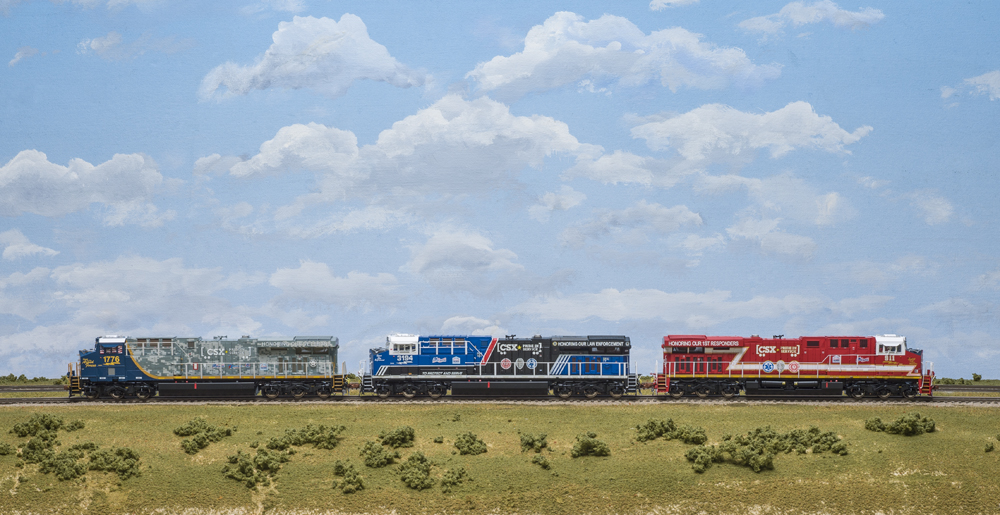
In 2019, CSX Transportation unveiled its Pride in Service locomotives, three General Electric (GE) ES44ACs painted to commemorate the service of military, first responder, and police personnel. Now, HO scale modelers can add these colorful locomotives with available dual-mode sound decoders to their fleets, thanks to ScaleTrains.com.
The prototype. General Electric introduced the ES44 line in 2005 after building demonstrator and pre-production locomotives in 2003. The ES44 replaced the AC4400CW and introduced GE’s new Evolution Series diesel engines, known as GEVOs.
These 12-cylinder engines were developed to meet the Environmental Protection Agency’s (EPA) Tier II emissions standards. Though they still produced 4,400 hp like the predecessor 7FDL 16-cylinder engines, they produced fewer emissions and used less fuel.
More than 7,000 locomotives were built. All of the North American Class 1 railroads – Canadian National, Canadian Pacific, BNSF, CSX, Norfolk Southern, and Union Pacific – bought from a dozen to more than 1,000 units, as did Florida East Coast, Kansas City Southern, Iowa Interstate, and Ferromex and Ferrosur in Mexico.
In 2012, GE introduced the ET44 series of locomotives, which meet the stricter EPA Tier IV emissions standard, replacing the ES models.
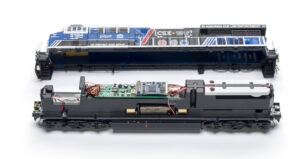
The model. ScaleTrains.com is offering the CSX Pride in Service locomotives in its Rivet Counter line, and as you’d expect, there are lots of details to count. Although, since it’s a modern unit, I could find no rivets.
Instead, I found underframe piping carrying sand, air, and electricity to various components, detailed GE steerable trucks with brake and sand lines, and detailed pilots with plows (front) and spare coupler knuckles (rear).
Brake and m.u. hoses hang from the pilots and m.u. cables are draped above the Type E lower-shelf couplers. Ditch lights illuminate and flash when the horn is sounded.
Etched metal grills cover the appropriate vents in the long hood, with visible bracing and fan blades behind some of the openings. All dimensions were within scale inches of drawings in the November 2004 issue of Model Railroader.
But the real eye-catcher is the multi-color paint schemes. I found several photos of these locomotives online, and all of the striping, lettering, and decals appear to be correctly placed. The only discrepancy I found was a missing warning label at the top of the pilot stairwell on the no. 3194 Spirit of Our Law Enforcement locomotive. All of the paint was smoothly applied and opaque with sharp separation of the colors.
The prototype locomotives were from separate orders. No. 3194 was part of the order built in early 2015 numbered 3175 to 3199. The no. 911, Spirit of Our First Responders, was built in 2008, part of a group numbered 800 to 949. No. 1776, Spirit of Our Armed Forces, was built as part of a 2013 order numbered 3065 to 3174, and originally assigned no. 3112.
Detail differences from the various production dates include engineer-side nose doors on the 1776 and 3194, heavy anticlimbers on the 911 and 3194, and different door and grill arrangements on the long hoods, all of which match prototype photos.
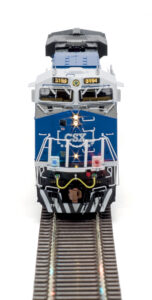
Under the hood. Removing the shell was easy. I unscrewed the couplers at the front and rear and lifted the body off the frame. Inside I found a horizontally split die-cast metal frame with the motor secured between the upper and lower halves.
An Electronic Solutions Ulm (ESU) LokSound V decoder was plugged into a motherboard secured to the top of the upper frame piece in the center of the locomotive. The speaker enclosure is mounted above the rear truck. Surface-mount light-emitting diodes were fitted at various locations around the frame to illuminate the ditch lights, headlight, number boards, ground lights, and walkway lights.
All wheels are powered and pick up electricity. A pair of brass flywheels helps smooth motor operation. The die-cast metal lower-shelf couplers were mounted at the correct height and the wheels were all in gauge.
On the test track. I began testing the ScaleTrains.com ES44AC with an NCE PowerCab Digital Command Control (DCC) throttle, recording a low speed of 1.6 scale mph at speed step 2 and a high speed of 68 scale mph in speed step 28. I got a similar speed range in direct- current (DC) testing. After the dual-mode sound decoder woke up at 8.5 volts, the locomotive started moving at 1.3 scale mph at 10.25V. Speed at 12V was 21 scale mph, and top speed at our power pack’s maximum voltage (14) was 60 scale mph.
With their nearly 1.5 pounds of weight, the ES44s produced 4 ounces of tractive effort, equivalent to 56 freight cars on straight and level track. Testing on the staff Milwaukee, Racine & Troy layout found a single locomotive stalling on the curve heading up the 3 percent grade out of Bay Junction with 13 heavy enclosed auto racks and an 86-foot high-cube boxcar behind it. I consisted a second locomotive with the first one, and the pair handled the load and the grade with no problem. The roar of two 12-cylinder GEVO engines only added to the excitement.
I also tested the locomotives on my home switching layout, where I had no trouble working through Atlas no. 4 turnouts in the yard and spurs.
While the sound effects had all of the expected features, the lighting included a few extras, such as the ground and walkway lights that illuminated when I triggered function 8, starting the diesel engine sounds. Our sample of no. 3164, the Spirit of Our Law Enforcement locomotive, had red and blue ditch lights. Of course, they flash when the horn is sounded. Photos of the prototype locomotive show standard white ditch lights now adorn the locomotive. Models with clear lights are also available.
Judging by the ease with which I found photos of these locomotives online, the Pride in Service fleet is popular. The locomotives are in regular service across CSX. A portion of the proceeds from these locomotives will go to the organizations benefiting from the Pride in Service program, so you don’t just get new models, you’re helping police, first responder, and veteran organizations with your purchase – a win all around.
Facts & Features
Price: $374.99 (DCC, sound), $264.99 (DC, no sound)
Manufacturer
ScaleTrains.com
7598 Highway 411
Benton, TN 37307
scaletrains.com
Era: 2019 to present
Road numbers and paint schemes: 911, Spirit of Our First Responders; 1776, Spirit of Our Armed Forces; and 3194, Spirit of Our Law Enforcement
Features
– 5-pole skew wound motor with dual flywheels
– Accurately profiled frame with separately applied plumbing and cabling
– All-wheel drive and electrical pick-up
– Detailed cab interior
– Die-cast metal semi-scale bottom shelf knuckle couplers at correct height
– Directional LED headlights
– Factory-applied wire grab irons, uncoupling levers, windshield wipers, mirrors, sunshades
– Late GE steerable trucks with separately applied brake cylinders, air plumbing, rotating bearing caps
– Multiple etched-metal see-through grills
– Nose door and other details as appropriate for prototype
– Operating LED front deck-mounted alternating ditch lights; front, rear, and side walkway lights; ground light on left side of locomotive; lighted number boxes
– Sound-equipped models have ESU LokSound V decoder and PowerPack with two super capacitors
– Weight: 1 pound, 7.5 ounces







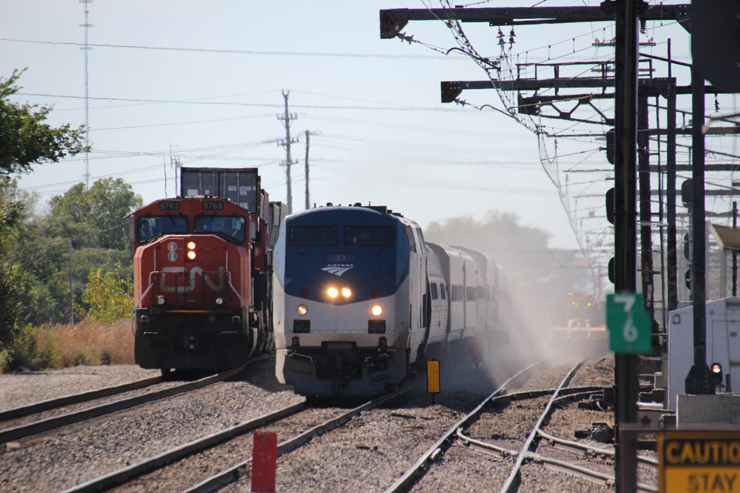
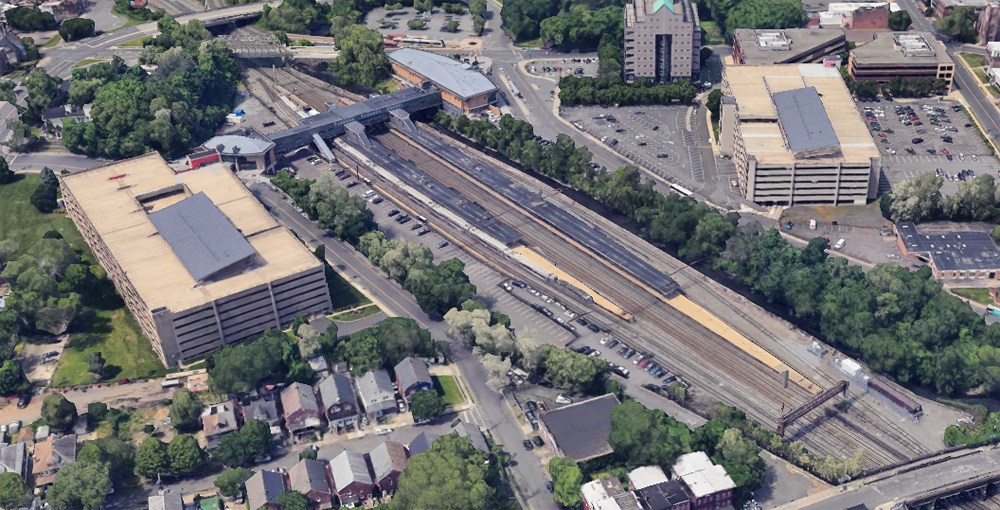
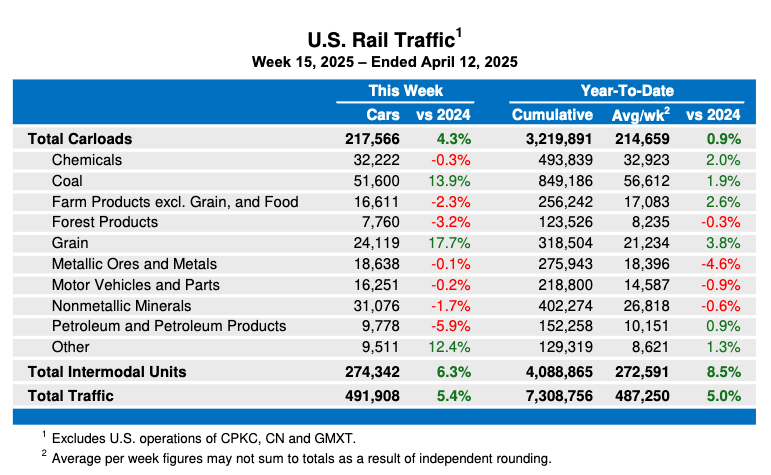




Excellent models by ScaleTrains, but it is a shame that they went through all the dozens of printing passes to try to get the Pride in Service paint schemes correct… but didn’t paint the yellow on the bottom of the handrail stanchions as the prototype CSX 911 and CSX 1776 have (those units, like most CSX units, have a solid yellow sidesill stripe from stepwell to stepwell including the bottoms of all the stanchions). The pre-production artwork had it right, but the production units arrived with molded/unpainted single color handrails (and before anybody says such painting couldn’t/can’t be done, ScaleTrains has already done it before – on the CSX C39-8s).
Even with all the advancements made in recent years, it is likely going to require model manufacturers to do metal (and painted) handrails for us to get accurate CSX and Santa Fe (warbonnet) models (as those also have painted bottom of stanchions). Metal handrails, along with being more durable, will also go a long way in making the units look better and not have the wavy plastic bowing in and out and giving that translucent look that screams it is unpainted plastic (and reviews using distant shots to try to hide the wavy plastic handrail issues).
The pulling power of modern HO scale 6-axle is impressive. 4 ounces or so is almost standard and I have seen even higher performance. The heavy weight helps, but I suspect that more accurate truck molding techniques that allow full pulling power by all 6 wheels firmly planted on the rails is also a factor. Even a slightly warped truck frame can shrink overall drawbar strength.
These are very well detailed, very solid units.
My one complaint, if you could call it that, is that there are so many fragile details, that even rough handling in shipping creates “issues” with parts coming loose and/or breaking off.
Fortunately, a tiny dot of CA on these small details holds them back in place without creating any “unsightly” marks,
Very well built, very nice, and very well liked!